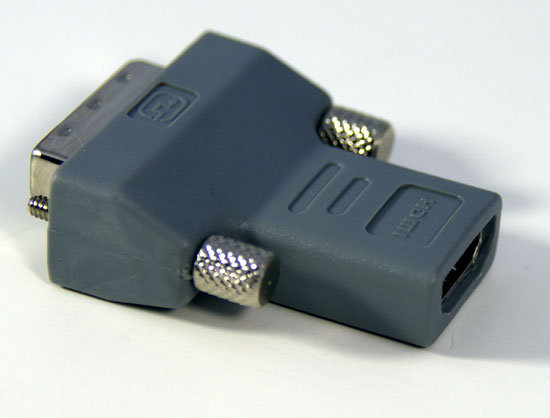ATI Radeon HD 4850 Preview: AMD Delivers Performance for the Masses
by Anand Lal Shimpi & Derek Wilson on June 19, 2008 5:00 PM EST- Posted in
- GPUs
8-channel LPCM over HDMI
You may have heard that I've recently become somewhat infatuated with HTPCs. I've been hammering on all of the AnandTech staffers to start looking at the needs of HTPC enthusiasts, and I've personally been on a bit of a quest to find the perfect HTPC components.
Blu-ray (and HD-DVD) both support Dolby TrueHD and DTS-HD audio encoding, which offer discrete 8-channel audio output. The problem is that there's currently no way to send a TrueHD or DTS-HD encoded stream from a PC over HDMI to a receiver, the stream must be decoded on the PC. Cyberlink's PowerDVD will decode these high definition audio formats just as well as any receiver into 8-channel LPCM audio, but you need support for sending 8-channel LPCM over HDMI.
Most graphics cards that implement HDMI simply pass SPDIF from the motherboard's audio codec over HDMI, which is unfortunately only enough for 2-channel LPCM or 6-channel encoded Dolby Digital/DTS audio. Chipsets with integrated graphics such as NVIDIA's GeForce 8200 and Intel's G35 will output 8-channel LPCM over HDMI, but AMD's 780G will not.
All of AMD's Radeon HD graphics cards have shipped with their own audio codec, but the Radeon HD 4800 series of cards finally adds support for 8-channel LPCM output over HDMI. This is a huge deal for HTPC enthusiasts because now you can output 8-channel audio over HDMI in a motherboard agnostic solution. We still don't have support for bitstreaming TrueHD/DTS-HD MA and most likely won't anytime this year from a GPU alone, but there are some other solutions in the works for 2008.

To use the 8-channel LPCM output simply configure your media player to decode all audio streams and output them as 8-channel audio. HDMI output is possible courtesy of a DVI-to-HDMI adapter bundled with the card; AMD sends audio data over the DVI interface which is then sent over HDMI using the adapter.










114 Comments
View All Comments
npp - Thursday, June 19, 2008 - link
This is a fantastic card, and if it really sells for around 150€ here in Europe, this is the way to go. Very impressive offering from AMD, I'm simply amazed!The 4870 will often outperfotm the latest nVidia card, I guess... Combined with the supposed refusal of Intel to grant nVidia rights for designing chipsets featuring QPI links, this may mean hard times for the guys in green. They were a little early announcing a war on so many fronts, as it seems. Honestly speaking, I was tired from their domination and insane prices anyway, so this is a very nice turning point.
js01 - Thursday, June 19, 2008 - link
I knew there was a reason why I've stuck with amd for the last few years, because I always get my money's worth. It must be painful to be an early owner of a 9800gtx right now considering the huge price drop.BikeDude - Friday, June 20, 2008 - link
Why do you have to stay with a particular brand? Are you not free to pick and choose the best deal when you need it?Those who bought the 9800GTX a couple of months ago have been able to get a lot of good quality gaming going while some of us have been waiting for the next great thing. Personally I have been waiting for a while now, I still have a 7800GTX! Was the waiting worth it? I doubt so.
That said, I would really welcome some insight into the driver quality of nVidia drivers vs ATI. nVidia has been disappointing for the past two years. Instability, features gone missing, anomalies introduced (like resetting the colour profile in Vista after login), etc...etc... At one point I was unable to play a DVD for more than 30 minutes before my computer froze. Downgraded the driver and all was fine again. Luckily nVidia fixed that in a later release, but come on... That one was bad, and there's nowhere I can file bug reports.
brentpresley - Thursday, June 19, 2008 - link
Would be great if someone can run Folding At Home on this card and publish the performance.The new NV client is smoking right now, and lots of us are pondering buying cards to fold on.
KCjoker - Thursday, June 19, 2008 - link
it gets way too hot for a single slot card dumping the hot air inside the PC. Should be better when some aftermarket cards come out. But why does it draw that much power when the chip is much smaller than Nvidia's?epsilonparadox - Thursday, June 19, 2008 - link
From the hints in the article, I would assume this is a very large chip that nullifies any benefits the smaller process would have provided. Plus AMD chose a single slot solution which probably isn't doing a good job of cooling the chip.fungmak - Thursday, June 19, 2008 - link
Well the power that is drawn is about the same as a 9800 GTX.However, the 4850 is rumoured to have 950 million trannies compared to the 750 million of the GTX. Also, the die size is rumoured to be around 275mm2 compared to 330 mm"2, so slightly higher density, though i would imagine this is offsite by the reduciton in power due to 55nm compared to 65nm. So all in all the power draw is actually not too bad.
andreschmidt - Thursday, June 19, 2008 - link
956 million transistors on 55nm fabrication process ;)ImmortalZ - Thursday, June 19, 2008 - link
The Multi-GPU pages seem to be broken - they go straight to the search page.derek85 - Thursday, June 19, 2008 - link
No the links are fine actually... Anandtech took this article offline for a very short moment for some reason and I hit the same problem during that time.